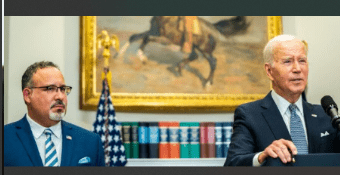Advocating for Inclusivity: Illinois’ Push to Ban Native American Mascots in Schools

Illinois lawmakers are at the forefront of a movement to ban Native American mascots and logos in K-12 schools, driven by a desire for cultural sensitivity and inclusivity. House Bill 5617, sponsored by State Rep. Maurice West, has ignited discussions on the impact of such mascots on the learning environment, prompting calls for change. This legislation marks a significant step towards acknowledging and rectifying the potential harm caused by culturally insensitive symbols in educational settings.
READ: New York Businesses Ordered to Require Masks Indoors or Vaccine Proof
Ban Native American Mascots The Need for Change:
As of 2021, more than 50 high schools in Illinois feature Native American names or imagery for their mascots, contributing to a broader national trend identified by fivethirtyeight.com, which identified over 1,200 high schools across the U.S. using Native American-themed mascots and logos in 2020. Critics argue that such mascots perpetuate harmful stereotypes and contribute to a hostile learning environment, particularly for Native American students. The bill seeks to address these concerns by mandating schools to alter logos, mascots, or names with Native American affiliations, fostering a more inclusive atmosphere.
Legislation Details:
House Bill 5617 introduces comprehensive measures to ensure the phased removal of Native American mascots from Illinois schools. The legislation requires schools to change their mascots by the deadline of September 1, 2027. This extended timeframe allows educational institutions ample opportunity to transition to new logos, acquire new uniforms, and update athletic facilities, minimizing disruptions. The bill also prohibits schools from selling items featuring banned mascots and mandates the removal of banned logos from school property.
The Impact on Learning Environment:
During a press conference, Dr. Megan Bang, Director of the Northwestern University Center for Native American and Indigenous Research, emphasized that Native American mascots create a hostile learning environment. She argued that their pervasive presence not only harms children but also contributes to a society based on inaccurate information and harmful perceptions. Research suggests that mascot names such as Warriors, Indians, and Braves can have a detrimental effect on Native American students, reinforcing stereotypes and negatively influencing their self-esteem.
National Trends and Similar Initiatives:
Illinois joins other states in addressing the issue of Native American-themed mascots in schools. In 2021, New York passed a law banning such mascots, requiring schools to retire them by 2025 unless they obtain approval from a recognized Native American tribe. Washington state implemented a similar policy, necessitating schools to seek permission from the nearest federally recognized tribe to use a Native American mascot. These actions reflect a broader national conversation about cultural sensitivity and respect within educational institutions.
The Role of Advocates and Lawmakers:
Advocates for banning Native American mascots argue that this legislative initiative aligns with broader goals of creating a more inclusive and respectful learning environment for all students. Rep. Laura Faver Dias, co-sponsor of the bill, highlighted the potential divisiveness caused by racist mascots, drawing on her experience as a former public school teacher. The intention is not only to eliminate offensive mascots but also to address the social impact, fostering unity among students and communities.
Conclusion:
Illinois’ House Bill 5617 represents a significant step toward acknowledging the impact of Native American mascots on educational environments. By setting a deadline for mascot changes, the legislation provides schools with a clear framework for transition while sending a powerful message about cultural sensitivity and inclusivity. As the debate continues, it remains a testament to the ongoing efforts nationwide to foster respectful and diverse learning environments within schools.




